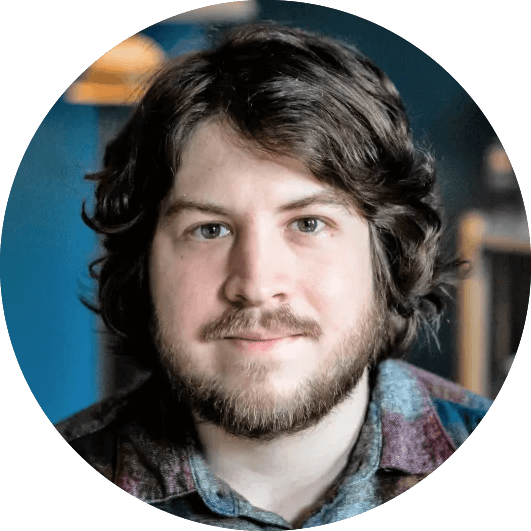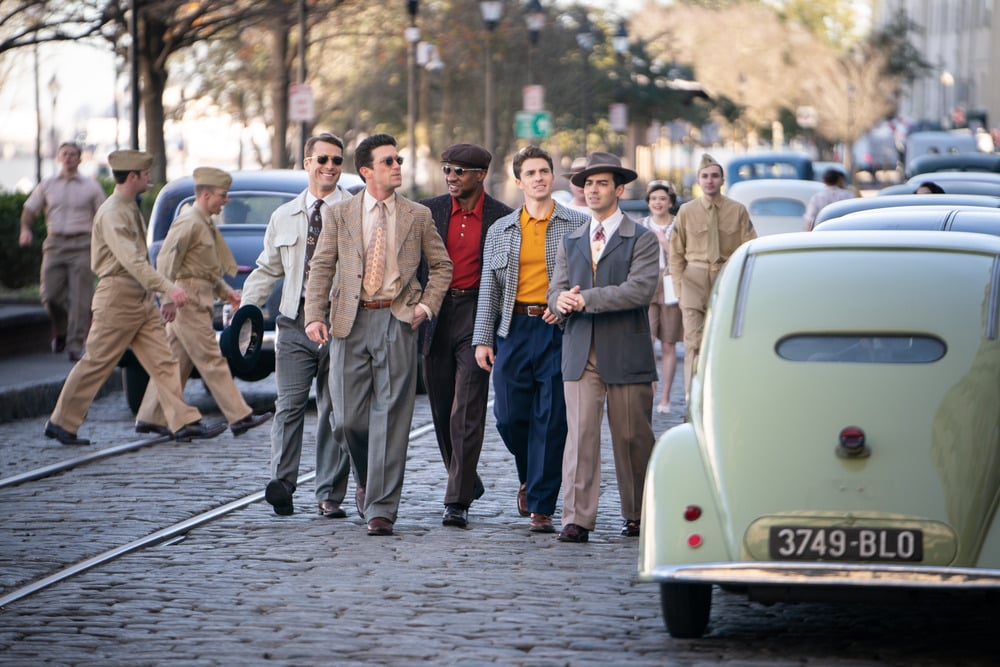Co-Supervising Sound Editors Will Files and Matt Yocum went to great lengths using sound to imbue Devotion with authenticity, excitement, and subtlety.
Based on true events, Devotion dramatizes the bond formed by Navy pilots Jesse Brown and Tom Hudner, among the first airmen deployed at the outset of the Korean War. For every dogfight and bombing run, there’s an equal amount of tension surrounding Brown’s role as the Navy’s first Black aviator, the rampant racism of 1950s America, and the sacrifices both men must make. We spoke to co-Supervising Sound Editors Will Files (The Batman, War for the Planet of the Apes) and Matt Yocum (The Last of Us, Hotel Transylvania 4) about Director J.D. Dillard’s vision for the film, recording a vintage fighter plane, and finding a balance between realism and dramatic effect.
What kind of guidance or direction were you given when tasked with shaping the sound of the film?
Matt Yocum (MY): One of the first discussions that Will and I had with J.D. was about how to make an authentic period piece that straddles the line between feeling representative of the time period and having the polish of a Hollywood film. It was made evident from the beginning that our goal was never to make a super-stylized, clean Hollywood soundtrack. It was way more important to err on the side of authenticity and just create a visceral reality that these characters experience. One of the important things from the beginning was to get the sound of the airplanes right. We didn't want to do a ton of Hollywood sweetening. Obviously, some stuff gets punched up where it needs to, but the goal of it really was for the audience to feel like they were sitting in the cockpit. But there’s also a lot of subtlety and nuance that comes through in the quieter scenes. Whether we're in Jesse's home in Rhode Island, on the beach in Cannes, or in Korea, we wanted the world to feel immersive and make us feel like we’re there with the characters.
Will Files (WF): It’s always fun to do a film with a director you’ve worked with in the past, because there’s a shorthand to the creative work. J.D. is one of those great filmmakers who has a very clear vision for the film but still gives us the room to experiment and try things he might not have thought of or expected. That gives us room to push things a bit and find the creative boundaries – it’s a much more satisfying way to work than just playing it safe and making obvious choices. Like Matt said, a lot of the early conversations were about creating a feel of authenticity, but also helping the audience be in Jessie’s head emotionally. The film has a large scale and scope, but at its core, it’s a very personal and intimate film, so we knew going in that balancing those two things sonically was going to be crucial to the film’s success.
Matt Yocum (left), Will Files (right)
Since the film features real Korean War-era aircraft, were you able to get any usable recordings during production?
MY: The production mixer got in touch with us early on and asked what they could do for us, and we just said, “Any extra material that you guys can record on the day, if you have time to set up two extra mics, whatever it is, we'll take any and all of it,” and they were actually super gracious in providing a lot of great material. After we finished rushing through the first temps and had some time to further develop the movie, I gave our sound effects editor Ryan Sullivan the task of going through those production folders, and we ended up creating a pretty substantial library out of it. There was some material in there that was invaluable.
One of the best things that we got from production, which ended up kind of saving us, was the sound of the helicopter they use to take off from and land on the carrier, and for the search and rescue mission near the end. That is a specific period helicopter and a type of engine that doesn't sound like any modern helicopter. We tried layering in different helicopters and J.D. was just like, “It's not what the thing sounds like,” but thank goodness it was in that production material. Ryan hit me up and was like, “by the way, there's this helicopter.” It was like a golden nugget in there, and that's part of the sound that's in the film. We sweetened it with other rotor blades and stuff, but the engine is from the production team. It was hugely helpful to have that from them.
WF: We were hoping to get more plane recordings during production, but coordinating with production schedules, especially with the air unit, was really hard. Of course we thought, “Let's take advantage of these planes while we have access to them,” but they couldn't really take the time while shooting to do what we needed. We ended up setting up a separate recording session with one of the planes in the movie, and Matt can talk all about that because he actually went up there and did it.
"It was made evident from the beginning that our goal was never to make a super-stylized, clean Hollywood soundtrack. It was way more important to err on the side of authenticity and just create a visceral reality that these characters experience."
Jesse Brown (Jonathan Majors) in Columbia Pictures' DEVOTION.
How did you get the opportunity to record a real Corsair fighter?
MY: The Corsair that we recorded at the Erickson Aircraft Collection up in Oregon was actually the same plane that was flown in the movie. J.D. got in touch with the aerial coordinator, Kevin LaRosa, who also did Top Gun, and Kevin contacted the Erickson Museum for us. The people that collect these types of aircraft are really passionate about them and care about them, so when we told them that we wanted the authentic sound to put in the movie, they were all about it. I would say probably 95% of the sound of the planes that you hear in the final product is from that one recording session, so it was invaluable to get to do that. I also want to give a shout out to Kai Paquin, the recordist who went up to Oregon with me. Kai is an extremely thorough and talented recordist; he showed up with a spreadsheet and schematics for the airplane – the whole nine yards.
When you get an opportunity like that, you’ve got to make the most of it. How did you cover all the different perspectives you needed for the wide shots, close-ups, passes and interior cockpit shots?
MY: Part of the intent of the recording session was to get sounds from inside the cockpit and the exterior of the plane as it was flying. We also recorded a lot of bys from the ground. Once we had finished doing all of the aerial maneuvers, they landed the plane and we got to record the sound of the engine cooling down. It’s this huge, 2,000-horsepower block of hot metal warping and clicking and popping. Then, they actually strapped the plane down to the tarmac and did a bunch of simulated movements for us where they would rev the airplane with different variations of power so that we could move around the plane safely on the ground and get isolated sounds to help create that dynamic feeling in the final soundtrack.
The real value of that session was getting so many mic angles and different perspectives on the plane. That was important to J.D. too. A lot of films will cheat movement of vehicles or aircraft by just doing a whoosh or a by for every movement, but he was like, “If the plane's moving from left to right in the frame, but we're behind it, I don't want a by sound.” So we needed a steady sound that phases and does that natural stereo field shift, not just a by whoosh.
There are a few different planes in the movie – the American pilots start out flying the F8F Bearcat before being assigned to the F4U Corsair, and at one point they encounter a MiG-15, a newer jet fighter with huge guns. How did you go about crafting different sonic identities for each of those aircraft?
MY: The Bearcats are sleek and petite; kind of like the Ferrari version of an airplane. They're designed to go fast and be really maneuverable. But, by the time World War II was over, the Corsair became the main aircraft for the Navy, so they switched over to these super souped-up planes with 2,000 horsepower engines. If the Bearcat is a Ferrari, the Corsair is like a supercharged American muscle car. For the sound of the MiG-15, we pulled a combination of different sounds that were available to us and crafted something that felt mean and ferocious, almost like the shark in Jaws, when it dives in from above.
J.D. had a lot of contact with the military advisors who told him about how the different guns on these planes functioned, and one of the interesting things about the MiG is that its main cannons shoot these tennis-ball sized rounds, like a mini cannon ball. It's a slower shooting speed, but the people at the VFX house actually figured out what the exact firing rate per minute on that gun was, and then we timed our gunshots to be exactly that so that we could line up with the VFX. It was a marriage of information between two different departments to create something that works in sync. We wanted that gun to sound distinct from the rest and to give it a sense of danger, but we didn't have the opportunity to record a real MiG, so that’s part of the “Hollywood” sound. We did reference footage of MiGs just to make sure that we were in the right neighborhood and not doing something that was totally out of left field.
Much of the film takes place on an aircraft carrier, in a variety of environments including the flight deck, superstructure, hangar, briefing room, and berthing areas. What elements did you use to build those different soundscapes?
MY: The sound of the ship is something that we experimented with from day one. One of my original ideas was to have different rhythmic elements depending on where you were in the ship, like it was sort of alive and breathing. A lot of the initial concepts that we brought to the table were a little too busy for J.D., so we pared back the rhythmic elements and left just a low rumble anytime you're inside the ship. Then, we made sure to fill out the atmosphere and give it a sense of life through things like loop group recording and walla. Eliza [Pollack Zebert], our Dialogue and ADR Supervisor, recorded a ton of extra banter between the squadron, PA callouts, and movement stuff in basically every scene in the movie.
For cutting all the artifacts and ambiances, Pro Sound Effects libraries like Odyssey and the Richard King material were invaluable. We don't always have the luxury of time to go out and record every single element that we need for a film of this scope, so reaching into our libraries for material like this is really helpful. That's part of the importance of a collection like Pro Sound Effects offers – you've got people whose careers are spent assembling all of this amazing material.
WF: What's great about having a good library to lean on is that you can spend the time to record the things that are really going to matter for the film, like having the chance to record vintage airplanes. By the time we got an opportunity to do that session, we'd already cut a pass of film, so we weren't really even in need of sounds at that point. Because we had such an excellent library to lean on, we were able to cut a version of the film without the custom recordings that was still pretty good. That freed us up to spend the time recording the stuff that we really needed to make it extra special. A lot of other things, like the bow wash from the ship, for example, you try to record the real thing and it doesn't sound good. They often just end up sounding boring or small, and it makes it not feel cinematic. So a lot of the time we're taking things like fire hose spray and slowing it down or making new sounds out of stuff in the library. So even though we're using a library, we're almost always putting a spin on it. We're essentially using it as raw material to create a new palette of sounds for the film.
"For cutting all the artifacts and ambiances, Pro Sound Effects libraries like Odyssey and the Richard King material were invaluable. We don't always have the luxury of time to go out and record every single element, so reaching into our libraries for material like this is really helpful."
(L to R) Tom Hudner (Glen Powell), Bill Koenig (Daren Kagasoff), Jesse Brown (Jonathan Majors), Bo Lavery (Spencer Neville) and Marty Goode (Joe Jonas) in Columbia Pictures' DEVOTION.
While Devotion is a war film by genre, the story is framed by the culture of racism in 1950s America. How did that inform your treatment of the sound, compared to any other war movie?
WF: It's very much woven into the fabric of what the film is, but J.D. was treating it with such a deft hand that it doesn't come off as being overtly about that, even though it's all about that. Jesse was working so hard to be just another pilot – he wasn't trying to be a Black pilot, he was just trying to be a pilot. The movie treats him very neutrally, and that's the point. So I think we either consciously or subconsciously did the same thing sonically. We tried to treat his home life and really everything about him that way. For example, the way we approached Jesse and his wife’s house was to make it sound like any other idyllic suburban house because they're living in the same quarters as any other airmen would. We didn't give his footsteps any more weight because he was the hero or anything like that.
There’s a scene where Jesse stands in front of a mirror reciting some of the horrible things bigots have said to him, and there’s a subtle element of low-frequency sound design that really heightens the tension. How did you arrive at the right sound for those moments?
WF: We were almost trying to evoke the feeling of being in his head and hearing the blood rush as his blood pressure is rising, and then the spell breaks and he's back. That was a really hard moment to get right. We spent a lot of time on that moment, believe it or not.
MY: One of the beautiful things sound can do psychologically is help to ground you in the world and put you in the perspective of the character's heads so that you identify with the character and feel like you're in their shoes as opposed to being a third-party voyeur. When we're in the moment with Jesse at the mirror, I don't feel like I'm watching Jesse. I feel like I'm going through it as Jesse. That's one of the beautiful things about film, and I think sound plays a really large part in doing that.





_1000x667_thumbnail.jpg?width=1000&height=667&name=M-016_(D_12952_r)_1000x667_thumbnail.jpg)









